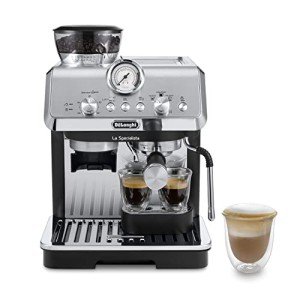The Art of Italian Espresso Machines: A Brewed Tradition
Italian espresso machines are not simply appliances; they are an essential part of Italy's rich coffee culture, representing a blend of artistry, engineering, and design. Coffee aficionados worldwide acknowledge the value of high-quality espresso, a staple of Italian life and cuisine. This article explores the history, mechanics, types, and aspects to consider when purchasing an Italian espresso machine, reflecting the depth of this precious beverage and its brewing approaches.
History of Espresso Machines
The espresso machine's development go back to the early 20th century in Italy, where coffee was not simply a drink however a vital social routine. The initial efforts to brew espresso begun with simple, stove-top designs, slowly progressing into intricate machines that could reproduce the perfect brew.
- 1901-- The First Espresso Machine: The first steam-powered espresso machine, known as the "Ideale," was established by Luigi Bezzera. More Information and facts marked a turning point in espresso brewing.
- 1938-- The Lever Machine: The introduction of the lever machine made it simpler to manage the pressure utilized in espresso extraction, enhancing taste consistency.
- 1947-- The Automatic Machine: Reaching more customers, Gaggia launched the first automatic espresso machine, more popularizing espresso bars.
- 2007-- The Digital Age: Technological advancements led to the birth of fully programmable machines, allowing users to customize their developing settings to achieve a customized coffee experience.
Secret Features of Italian Espresso Machines
Italian espresso machines embody precision, workmanship, and development. Here are some crucial components that highlight their significance:
| Feature | Description |
|---|---|
| Boiler Type | Identifies how heat is generated and kept. Common types consist of single boiler, dual boiler, and heat exchanger. |
| Group Heads | Where the coffee is brewed; commercial machines often have numerous group heads for performance. |
| Pressure Control | Vital for attaining the perfect espresso; most machines run at 9 bars of pressure. |
| Frothing Capabilities | The steam wand permits milk frothing, necessary for drinks like cappuccino and latte. |
| Construct Quality | The products utilized (stainless steel, brass, and so on) influence durability and heat retention. |
Kinds Of Italian Espresso Machines
Choosing the ideal machine hinges on user preferences, budget, and planned use. Below are the primary types of Italian espresso machines:
Manual Espresso Machines
- Pros: Offer full control over the developing process, allowing for a personalized touch.
- Cons: Require ability and practice, can be labor-intensive.
Semi-Automatic Machines
- Pros: Provide a balance between automated and manual procedures; users manage water flow.
- Cons: Can have a steeper learning curve than totally automatic machines.
Totally Automatic Machines
- Pros: Simplify the developing procedure with push-button operations; suitable for novices.
- Cons: May compromise some of the nuances of manual brewing.
Super-Automatic Machines
- Pros: Grind, tamp, brew, and froth instantly; practical for busy lifestyles.
- Cons: Less control over the brewing variables, potential for a less genuine espresso experience.
Buying Guide: Factors to Consider
Selecting the perfect Italian espresso machine can be complicated, however thinking about the following elements can simplify the decision-making process:
- Budget: Italian espresso machines vary from affordable to high-end designs, so set a budget upfront.
- Usage Frequency: Evaluate how often you will use the machine; everyday users might want a more durable option.
- Space: Measure your kitchen or counter space; some machines can be big and require adequate clearance.
- Upkeep: Consider ease of cleansing; machines with removable parts or integrated cleansing functions may lower maintenance.
- User Skill Level: Beginners may prefer totally or semi-automatic machines, while knowledgeable baristas can manage manual machines.
- Brand Reputation: Research brand names known for quality, such as Breville, Gaggia, and La Marzocco.
Popular Italian Espresso Machine Brands
Italian workmanship is renowned for producing some of the very best espresso machines worldwide. Here are top brands worth considering:
- Gaggia: Known for its home espresso machines and cost.
- La Marzocco: A premium brand name understood for its commercial-grade machines and innovative technology.
- Rancilio: Renowned for its durable build and professional-quality machines ideal for home and commercial use.
- Sage/Breville: Offers advanced functions and easy to use designs, ideal for both novices and enthusiasts.
Frequently asked questions
What is the difference between espresso and routine coffee?
Espresso is a focused coffee brewed by forcing warm water through finely-ground coffee under pressure. It has a thicker consistency, richer flavor, and greater caffeine concentration than regular coffee.
Can I make milk-based drinks with an espresso machine?
Yes, lots of Italian espresso machines feature a steam wand to froth milk for drinks like coffees, lattes, and macchiatos.
How typically should I clean my espresso machine?
Regular maintenance is necessary. Normally, a thorough cleaning is recommended every few weeks, while descaling must be done every 1 to 3 months, depending on water hardness.
What is the perfect pressure for brewing espresso?
The ideal pressure for brewing espresso is around 9 bars. This pressure makes sure the optimum extraction of flavors from the coffee premises.
Are more costly machines worth the investment?
Higher-end machines typically utilize better products and innovation, providing improved sturdiness and more constant results. For serious coffee lovers, purchasing a good machine can raise the espresso experience substantially.
Italian espresso machines are far more than mere brewing gadgets; they are a celebration of a cultural tradition that has influenced coffee consumption worldwide. With numerous models available to fit any user's requirements-- ranging from amateurs to skilled baristas-- there is an Italian espresso machine completely suited for everybody. As you start your espresso journey, understanding the history, mechanics, and alternatives will enhance your experience and appreciation for this time-honored drink. Whether you look for to recreate a café ambiance in your home or fine-tune your brewing method, these machines are capable of delivering memorable cups of espresso embellished with the abundant history of Italian coffee culture.

